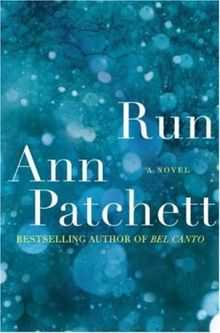Run (novel)

Run is a 2007 novel by American author Ann Patchett. It is her first novel to be published since her widely successful Bel Canto (2001).
Plot summary
This novel tells the story of Bernard Doyle, an Irish Catholic Boston politician. He married, had one son, and adopted two more. The adopted kids are African-American brothers named Tip and Teddy. (The adoptees' names were given to them by the Doyles as a tribute to the Massachusetts politicians Thomas "Tip" O'Neill and Edward "Teddy" Kennedy) Four years later, Doyle loses his wife to cancer. Sixteen years after his wife's death, their two adopted sons are University students. Bernard, the former mayor of Boston, has invited them to a Jesse Jackson lecture. After the lecture, Bernard asks his sons to go to a reception. Tip declines and backs off a curb into the path of an oncoming car. A woman in the crowd pushes him out of the way and is injured in the process. The novel's plot centers around the story of that woman's identity. Her daughter, an 11 year old girl named Kenya, asks to live with the Doyles. The plot has to do with interracial adoption, familial allegiances and rivalries, Boston’s notoriously complex political and racial history.
Reception
Leah Hager Cohen, of The New York Times, reviewed the book, saying:Nora Seton, of the Houston Chronicle: "This is a novel staffed exclusively by protagonists, and Patchett's often dazzling insights cannot lift it into second gear. Run would have profited from a brutish and anguished soul."[2]"If Patchett had exhumed her characters’ motivations more thoroughly, she might have persuaded readers of the circumstances that led to such a choice. And in so doing she might have elicited deeper sympathy and interest. The Jesse Jackson lecture turns out to be little more than a set piece, and the characters’ racial identities are either ignored or too broadly indicated. (Kenya and her mother live in a housing project; Kenya, Tip and Teddy are all endowed with a stereotypical black athletic gift, a talent for running.) It’s difficult to understand why an author would seed her story with potentially rich material only to refrain from exploring it. But this might explain why Patchett’s characters ultimately feel less real than symbolic, as wooden as the Virgin’s statue."[1]
Writing for The New Yorker, John Updike offered the following insight: "As realism, her novel is pale; but as a metaphoric representation of growth it transcends its sentimentality."[3]
Andrew O'Hagan, Signature Review for Publishers Weekly: " ... the book is lovely to read and is satisfyingly bold in its attempt to say something patient and true about family."[4]
Run is a New York Times bestseller.[5]
References
- ↑ http://www.nytimes.com/2007/09/30/books/review/Cohen-t.html
- ↑ http://www.chron.com/disp/story.mpl/life/books/reviews/5189344.html
- ↑ http://www.newyorker.com/arts/critics/books/2007/10/01/071001crbo_books_updike?currentPage=2
- ↑ http://www.publishersweekly.com/article/CA6459864.html?q=run+ann+patchett
- ↑ http://www.nytimes.com/2008/09/07/books/bestseller/bestpapertradefiction.html
External links
- http://www.post-gazette.com/pg/07294/826610-148.stm/
- Guardian Review
- The Independent Review
- http://entertainment.timesonline.co.uk/tol/arts_and_entertainment/books/fiction/article2436947.ece/